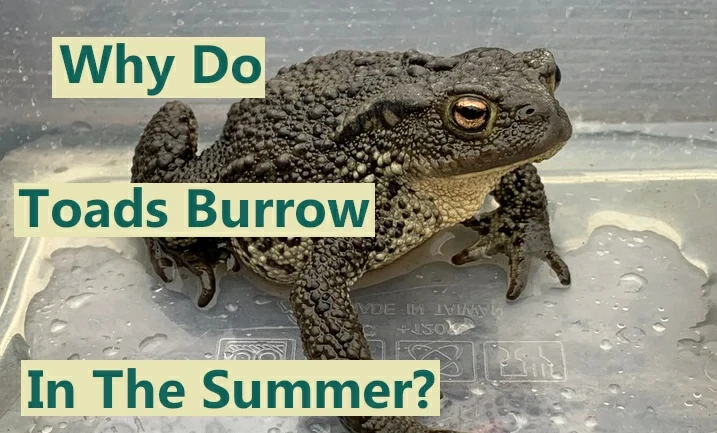Toads and other amphibians are most active in the warm spring and summer months. During hot periods in the summer, it’s common to see toads burrowing and burying themselves in the sand.
Toads burrow in the summer to cool off from the hot temperatures. Sand is a poor thermal conductor, so a toad buried in the sand can stay cool, even in hot weather.
Many species of toads have hardened knobs on their back legs which they use to dig themselves backward down into the ground.
That said, not all toads will burrow. Rather than burrowing into the sand, some toads hide under rocks, logs, natural holes, or abandoned small mammal burrows.
Toads Burrow in the Summer to Escape the Heat
Toads are ectothermic or “cold-blooded” animals. This means that toads cannot generate their own body heat, so their body temperatures are close to the temperature of their environment.
In other words, their environment is the main influence on their body temperature.
This contrasts endothermic (warm-blooded) animals, like humans whose bodies can generate their own internal heat through their metabolism.
Due to being cold-blooded, toads are very vulnerable to temperature extremes.
If the summer temperature rises above a certain point, a toad can overheat and be killed or injured.

For this reason, many toads burrow in soft soil in the summer to escape extreme temperatures and only emerge when the conditions are more favorable.
While buried, toads rely on cutaneous respiration to breathe, and can even change their body positions to adjust heat exchange via conduction and radiation.
How deep toads burrow varies depending on the species and other factors. Some toads can burrow anywhere from 6 inches to over 3 feet deep.
Sometimes, Toads Estivate in the Summer
Many people know that toads hibernate in the winter, to survive the freezing temperatures.
However, freezing temperatures aren’t the only thing toads have to worry about.
Being cold-blooded animals, high summer temperatures are just as undesirable as the cold. This is where estivation (also spelled as aestivation) comes in.
Estivation is when an animal enters a state of dormancy to conserve energy when the environmental conditions are very hot and dry.
The breathing rate, heart rate, and general metabolic rate all decrease, just as they do in hibernation. Think of it as some sort of summer hibernation.
If the summer weather gets too harsh, toads will retreat into burrows or find a cool, moist place to estivate as they wait for the rain to come and the temperatures to drop.
If the rain comes, but the temperatures remain high, they will not emerge until the temperatures are cooler.
Other Reasons Toads Burrow in the Summer
Temperatures are not the only reasons toads may burrow in the summer. Toads may burrow for several other reasons.
1. Toads Burrow to Hide From Predators
Toads are fairly small creatures and are preyed on by many animals, such as birds, snakes, certain, small mammals, fish, and even large spiders.
For this reason, toads have developed many ways to defend themselves against predators.
Depending on the species, toads may rely on camouflage, toxic skin secretions, mimicry, and other tactics to ward off predators.
Many toads may also bury themselves in soft soil to go unnoticed by predators.
2. Toads Burrow to Ambush Prey
Toads are generally not fast-moving creatures. This means they can not actively chase after prey as some other predators do. Instead, they wait for the prey to come to them, by using a passive ‘sit and wait’ hunting strategy.
This is an ambush-style technique where the toad hides in shady areas or burrows slightly in the mud and then pounce on any prey that passes by.
Toads have sticky tongues that allow them to catch any moving insect that comes into range quickly.
Once a toad spots an insect, it launches its tongue to catch the prey. After catching the prey, the tongue wraps around it and coats it with sticky saliva.
The toad will then yank its tongue back with a force equal to twelve times greater than the force of gravity.
Once the insect is in the mouth, the toad will swallow it whole.
A toad can shoot out its tongue, capture an insect, and pull it back into its mouth within 07 seconds; which is five times faster than the human eye can blink. This speed makes it effective at catching even fast-flying insects such as flies.
Not All Toads Burrow in the Summer
While many toads will burrow when the summer temperatures get too harsh, it’s important to note that not all toads burrow.
Some toads will retreat to natural holes, or abandoned small mammal burrows. Other toads will hide under logs, in rock crevices, the foundations of old buildings, piles of rubble, and other hidden areas.

If you ever go around turning over large rocks, or logs during the summer, there’s a chance you could find toads hiding underneath.
Frequently Asked Questions
Where do toads go in the summer? In the summer, toads retreat to protected areas that can shield them from the hot temperatures. Some toads will burrow and burrow and bury themselves in soft soil, or leaf litter. Other toads will hide under rocks, logs, in the foundations of old buildings, and other cool hidden areas.
Why do toads burrow? Toads burrow for several reasons, including; hibernation, to escape the hot or cold temperatures, to hide from predators, and to ambush prey.
Conclusion
Frogs and toads have thin membranous skin that they use to breathe and absorb water.
Due to their permeable skin, toads are very prone to water loss from the skin, particularly in arid conditions.
For this reason, many toads will burrow and bury themselves if the summer weather gets too harsh.
Toads can stay burrowed for several weeks and only emerge when the rain falls, or the temperatures become more favorable.

